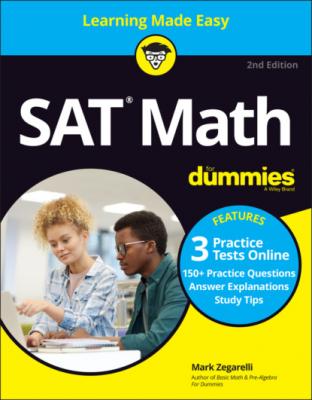SAT Math For Dummies with Online Practice. Mark Zegarelli
Чтение книги онлайн.
Читать онлайн книгу SAT Math For Dummies with Online Practice - Mark Zegarelli страница 16
 the second fraction to its reciprocal. For example:
the second fraction to its reciprocal. For example:
|
|
|
|
As when multiplying fractions, you can sometimes make dividing fractions easier by canceling common factors in both the numerator and denominator. Be careful to cancel factors after changing the division to multiplication. For example, when dividing
Now, cancel a common factor of 2 in both the numerator and denominator:
To complete the problem, multiply:
Connecting fractions and ratios
Once you understand how fractions work, you can easily grasp the related concept of a ratio, which is a measurement of the relative sizes of two numbers. For example, if you know that a pet store has a
Transforming a ratio to its related fraction in this way is often a good first step when answering SAT questions that involve ratios.
I discuss ratios, plus the related concept of proportional equations, in Chapter 7.
Review of decimals and percentages
Like fractions and ratios, decimals and percentages are two common ways to represent rational numbers that aren’t integers. On the SAT, you’ll probably need to convert decimals to percentages, and vice versa. In this section, I review this relatively simple process.
Converting decimals to percentages
To change a decimal to a percentage, move the decimal point two places to the right and attach a percent sign. For example:
|
|
|
|
As you can see from the last example, after changing a decimal to a percentage, you can safely drop unnecessary leading zeros.
In some cases, you may need to include one or more place-holding zeros in the percentage that you create. For example:
|
|
|
|
When a decimal includes three or more decimal places, the decimal point remains in the resulting percentage. For example:
|
|
|
|
Changing percentages to decimals
Converting a percentage to a decimal reverses the process I describe in the previous section. To convert a percentage that doesn’t have a decimal point, introduce a decimal point just before the percent sign, then move it two places to the left and drop the percent sign. For example:
|
|
|
|
As you can see from this example, after changing a percentage to a decimal, you can safely drop unnecessary trailing zeros.
For percentages that are less than 10%, introduce one or more place-holding zeros as needed into the decimal that you create. For example:
|
|
|
|
Absolute Value
The absolute value of a number is its non-negative value. For example:
|
|
|
|
As you can see, when absolute value is applied to a negative number such as –3, the minus sign is dropped. Otherwise, absolute value has no effect on non-negative numbers such as 5 and 0.
When evaluating an absolute value, evaluate the expression inside the absolute value bars, then apply the absolute value, and then evaluate the rest of the expression. For